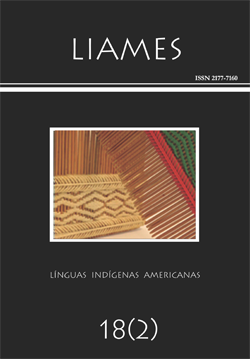Resumen
This article presents a description and analysis of the deontic modality and its relationship with mood category (realis vs irrealis) in Paresi, a language of the Arawak family, spoken in Brazil. Data were collected from two questionnaires on deontics and texts. For the analysis of the data, we used, as the theoretical framework on mood and modality, the works of Feldman (1986), Hacquard (2006, 2010); Mithun (1995, 1999) and Palmer (2001). First, we show how the realis/irrealis mood marking occurs in Paresi. In the sequence, we describe the Paresi as a language that lexically marks the type of modality, but not the modal force. We present two markers of deontic modality in this language: maika and wa(iye)hena, which indicate both necesssity and possibility. These markers exhibit particle properties and occupy high positions in the sentence structure. Finally, we describe the deontic modality of necessity, showing that there are two types of obligations in Paresi: one indicated by the maika particle; and another, by the particle wa(iye)hena. The first figures, preferably, in contexts in which a participant is directly responsible for the realization of the event and seems to be associated to the realis mood. On the other hand, wa(iye)hena is employed in contexts of laws and general rules, which describe how a state of affairs should be, and co-occurs, predominantly, with the irrealis marker.
Citas
Brandão, Ana Paula (2014). A reference grammar of Paresi-Haliti (Arawak) (Tese de doutorado). Austin: University of Texas at Austin.
https://repositories.lib.utexas.edu/handle/2152/24847
Brennan, Virginia (1993). Root and Epistemic modal auxiliary verbs (Tese de doutorado). Amherst: University of Massachusetts.
https://scholarworks.umass.edu/dissertations/AAI9316625
Cinque, Guglielmo (1999). Adverbs and functional heads: a cross-linguistic perspective. New York: Oxford University Press.
Cinque, Guglielmo (2006). Restructuring and functional heads: the cartography of syntactic structures. New York: Oxford University Press.
Elliott, Jennifer (2000). Realis and irrealis: forms and concepts of the grammaticalisation of reality. Linguistic Typology 5: 55-90.
doi: https://doi.org/10.1515/lity.2000.4.1.55
Exter, Mats (2012). Realis’ and ‘irrealis’ in Wogeo: A valid category? Language Documentation & Conservation Special Publication: Melanesian Languages on the Edge of Asia: Challenges for the 21st Century 5: 174–190. Disponível em: https://scholarspace.manoa.hawaii.edu/handle/10125/4564. Acesso em (15/05/2018).
Feldman, Fred (1986). Doing the best we can. An essay in informal deontic logic. (Philosophical Studies Series in Philosophy 35). Dordrecht, Boston: D. Reidel Publishing Company.
Hacquard, Valentine (2010). On the event relativity of modal auxiliaries. Natural Language Semantics 18(1): 79-114. doi: 10.1007/s11050-010-9056-4
Hacquard, Valentine (2006). Aspects of modality (Tese de doutorado). Cambridge: Massachusetts Institute of Technology. http://hdl.handle.net/1721.1/37421
Lyons, John (1977). Semantic, vols. 1–2. Cambridge University Press.
Matthewson, Lisa (2004). On the methodology of semantic fieldwork. International Journal of American Linguistics 70 (4): 369-415. doi: 10.1086/429207
Michael, Lev (2014). The Nanti reality status system: Implications for the typological validity of the realis/irrealis contrast. Linguistic Typology 18 (2): 251-288.
doi: https://doi.org/10.1515/lingty-2014-0011
Mithun, Marianne (1995). On the relativity of irrealis. In Joan Bybee; Suzanne Fleischman (eds). Modality in grammar and discourse. Amsterdam: John Benjamins.
Mithun, Marianne (1999). The languages of native North America. New York: Cambridge University Press.
Palmer, Roland (2001). Mood and modality. Cambridge: Cambridge University Press.
Rech, Núbia; Brandão, Ana Paula (2018a). A marcação de modalidade deôntica no Paresi. Fórum Linguístico 15(1): 2816-2827.
Rech, Núbia; Brandão, Ana Paula (2018b). Questionário para elicitação de deônticos: tempo passado. Ms.
Rech, Núbia S. Ferreira; Pires de Oliveira, Roberta; Guesser, Simone Lúcia; Lanes, Elder José (2017). Questionário para elicitação de deônticos: tempo presente. Ms.
Rech, Núbia; Varaschin, Giuseppe (2017). Predicados inacusativos e a modalidade deôntica. Revista Letras 96: 219-238.
Rech, Núbia; Varaschin, Giuseppe (2018). Predicados estativos e os tipos de deôntico: ought-to-do e ought-to-be. Cadernos de Estudos Linguísticos 60(1): 159-177.
Rullman, Hotze; Matthewson, Lisa; Davis, Henry (2008). Modals as distributive indefinites. Natural Language Semantics 16: 317-357. doi: 10.1007/s11050-008-9036-0
Silva, Glauber (2013). Morfossintaxe da língua Paresi-Haliti (Tese de doutorado). Rio de Janeiro: Universidade Federal do Rio de Janeiro.
Van der Auwera, Johan; Ammann, Aandreas (2013). Situational possibility. In: Dryer, M.; Haspelmath, M. (Ed.) The world atlas of Language structures online. Leipzig: Max Planck Institute for Evolutionary Anthropology. Disponível em http://wals.info/chapter/74. Acesso em (20/05/2017).
Zwicky, Arnold (1985). Clitics and particles. Language 61(2): 283-305. doi: 10.2307/414146
LIAMES: Lenguas Indígenas Americanas utiliza la licencia de Creative Commons (CC), preservando así la integridad de los artículos en ambiente de acceso abierto.


